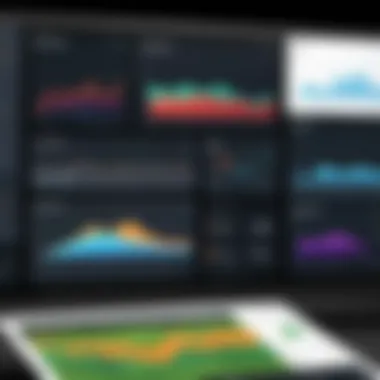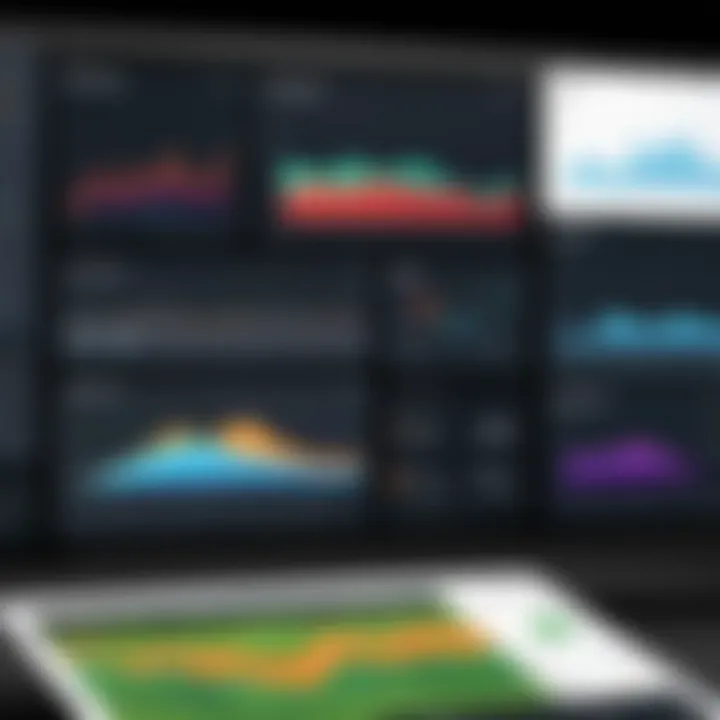Unlocking Potential: Golf Analytics Software Explained


Intro
Golf analytics software has evolved significantly in recent years, bringing advanced technology to a sport rooted in tradition. Players of all levels can leverage data to enhance performance and improve skills. This transformation is not only for professionals but also for amateurs looking to gain a competitive edge. With various tools available, understanding the functionalities and benefits is critical.
Brief Description
Overview of the software
Golf analytics tools serve to collect, analyze, and present data on a player's performance. These software solutions utilize sophisticated algorithms and vast datasets to offer insights into swing mechanics, shot accuracy, and course management. Some well-known software in the field include TrackMan, Arccos, and ShotScope. Understanding how these tools function can help players make informed decisions about their training regimens.
Key features and functionalities
The features of golf analytics software can vary significantly. Here are some essential functionalities to look for:
- Data Tracking: Continuous monitoring of swing data, putts, and other stats.
- Performance Analysis: In-depth breakdown of a player’s strengths and weaknesses.
- Simulation Tools: Real-time simulation to practice in various scenarios.
- Integration with Devices: Compatibility with smart devices and wearables.
Utilizing these functions allows players to tailor their practice sessions effectively. Analyzing this data can lead to significant improvement over time.
System Requirements
Hardware requirements
To run high-performance golf analytics software effectively, certain hardware specifications are necessary. Generally, a computer or device should include:
- A multi-core processor for efficient data processing.
- At least 8 GB RAM to handle large datasets.
- High-resolution display for detailed visual feedback.
Software compatibility
Compatibility with different operating systems is crucial for ease of use. Most programs are designed for both Windows and macOS. However, checking for specific system specs on the vendor's site before installation is wise. Moreover, some software may offer mobile applications for iOS and Android, enhancing accessibility.
Golf analytics software is transforming how players approach their game, ensuring that data-driven decisions take precedence. This trend marks a shift in golf training, emphasizing the importance of technology in sports performance management.
Intro to Golf Analytics Software
Golf analytics software has grown significantly in importance over the years, especially as the sport has become more data-driven. It provides players, coaches, and analysts with valuable insights that extend beyond traditional metrics. This software utilizes data to enhance performance, improve training methodologies, and shape strategic decision-making during plays.
In this article, we will explore various dimensions of golf analytics software, emphasizing its essential features and benefits. Understanding this topic is crucial for players at all skill levels who aim to leverage technology for better performance on the course.
Definition and Purpose
Golf analytics software refers to digital tools that collect and analyze performance data related to a golfer's gameplay. The purpose of this software is to furnish users with metrics that highlight strengths and weaknesses in their game. With this information, players can tailor their training regimens, adjust techniques, and make informed decisions during tournaments.
Various tools help in tracking swing speed, shot accuracy, putting efficiency, and overall performance against various course conditions. This targeted analysis allows golfers to focus on specific areas of improvement and refine their skills accordingly.
Historical Context
Looking back, the landscape of golf analytics has transformed immensely. Originally, performance tracking was limited to manual record-keeping and subjective observations from coaches. However, with advancements in technology, the introduction of software tools has revolutionized capability in golf analysis.
In the early 2000s, systems began to emerge that utilized statistical models to analyze player performances. These initial tools sparked interest from amateur and professional players alike. As technology advanced, data collection became more sophisticated with the integration of sensors and cameras. This progression paved the way for the current state of golf analytics, where software applications can perform real-time analysis based on comprehensive datasets. Today, golfers utilize advanced technology to gain insights that were unimaginable just a few decades ago.
Key Features of Golf Analytics Software
Golf analytics software has become an essential tool for players, coaches, and enthusiasts seeking to enhance their performance and understanding of the game. The key features of these software solutions serve as the backbone for effective performance analysis and improvement strategies. By focusing on specific elements, such as performance metrics tracking, swing analysis capabilities, and course management tools, users can tap into valuable insights that positively affect their gameplay.
Performance Metrics Tracking
Performance metrics tracking plays a significant role in any golf analytics software. This feature allows players to collect and analyze data related to their overall performance. Key metrics often include scores, fairways hit, greens in regulation, and putting statistics. Through such data, players can quickly identify strengths and weaknesses in their game.
Additionally, tracking these metrics over time helps in setting realistic goals and benchmarks. This continuous assessment can motivate players to improve their skills and focus on particular areas needing attention. Moreover, coaches can utilize this data to craft targeted training sessions that address specific performance gaps. Simply put, effective performance tracking empowers individuals to make informed decisions about their golfing practices.


Swing Analysis Capabilities
Swing analysis capabilities are another crucial component of golf analytics software. Utilizing advanced technology and sensors, many software solutions offer in-depth analysis of a player’s swing mechanics. These analyses often include metrics such as swing speed, angle of attack, and club path. With detailed feedback, players can understand the dynamics involved in their swings, leading to better technique and consistency.
Moreover, high-quality software may provide visual aids, including video capture and graphics depicting the swing trajectory. This aids in comprehension and gives tangible evidence of progress. For players aiming to refine their skills, swing analysis becomes a vital resource for achieving greater accuracy and distance in shots.
Course Management Tools
Course management tools are becoming increasingly popular features in golf analytics software. These tools allow players to analyze course layouts, assess hazards, and strategize shot selection according to their strengths and weaknesses. By leveraging GPS data, users can gain insights on distances to various targets, enabling smarter gameplay during rounds.
An effective course management tool can also recommend specific clubs for each shot based on historical performance in similar situations. This data-driven approach aids in making strategic decisions that can save strokes and reduce overall scores.
Utilizing these features allows players to develop a more tactical mindset on the course, ultimately improving both performance and enjoyment of the game.
"The integration of performance metrics tracking, swing analysis, and course management tools provides players with a comprehensive approach to enhance their game at all levels."
Benefits of Utilizing Golf Analytics Software
Golf analytics software is gaining recognition not only for tracking performance but also for its broader implications on training and gameplay. The advantages are multifaceted, affecting players of all levels—from amateurs to seasoned professionals. By integrating detailed data analysis into practice and competition, golfers can gain significant insights that can translate directly into improved performance on the course.
Enhanced Performance Insights
One of the core benefits of using golf analytics software lies in its ability to provide enhanced performance insights. This software collects extensive data points during practice sessions and competitive play, including swing speed, trajectory, and shot accuracy. The aggregation of this data helps players identify strengths and weaknesses in their game.
Using advanced algorithms, the software can present trends that may not be obvious during regular play. For example, a player may discover that their putting accuracy declines under certain conditions, such as longer distances or specific green types. With this knowledge, golfers can adjust their training focus to improve these areas, leading to overall better performance.
Furthermore, these insights can also be correlated with metrics from previous rounds to provide a more comprehensive look at progress over time. This can motivate players by showing their development through hard statistics, which is essential for understanding how practice translates to performance.
Personalized Training Programs
Golf analytics software also empowers the design of personalized training programs tailored to individual needs. By analyzing performance data, players and their coaches can create specialized practice regimens that address specific weaknesses.
For instance, if the software indicates that a player struggles with driving accuracy, the training module can focus on exercises that improve stance, grip, or swing mechanics. These data-driven training recommendations increase the efficiency of practice sessions and help players use their time productively.
Moreover, personalization extends beyond just techniques. Recommendations can include specific drills, practice schedules, and even mental strategies to improve focus and decision-making on the course. This holistic approach provides clear directions for improvement, making each training session purposeful and goal-oriented.
Improved Decision-Making in Gameplay
Improved decision-making in gameplay is another critical advantage of golf analytics software. The software can analyze previous rounds, offering insights on shot selection and course management. Armed with this data, players are less likely to rely on intuition alone.
For example, data may reveal that a player performs better with a 5-iron from a particular distance rather than a driver, even if the latter seems intuitively appealing. Understanding these nuances allows players to make informed decisions that can lead to lower scores.
Additionally, the software can model different scenarios, showing how certain strategies might affect outcomes. For example, it might display how playing conservatively on a specific hole impacts overall performance across a round. This analytical approach not only boosts confidence but also enhances strategic thinking, leading to smarter gameplay.
In summary, the benefits of utilizing golf analytics software extend beyond mere performance tracking. Enhanced performance insights, personalized training programs, and improved decision-making fundamentally equip golfers with the tools needed for advancement in their game. The information derived from such software represents a significant shift in how golfers approach their play, fostering a culture of continuous improvement through well-informed data analysis.
Types of Golf Analytics Software
Understanding the types of golf analytics software is crucial in the context of this article. Each type serves unique purposes and offers specific benefits, making it vital for players, coaches, and even businesses involved in the sport. The choice of software can significantly affect the outcomes of performance tracking and analysis, thus impacting overall results.
Mobile Applications
Mobile applications for golf analytics have gained significant traction in recent years. Their convenience allows players to access performance metrics, swing analysis, and course management on-the-go. Many of these apps are user-friendly and designed for both amateur and professional levels.
Common features found in these mobile applications include:
- Performance Tracking: Players can log their scores, track stats, and monitor progress directly from their mobile devices.
- Swing Analysis: Some apps offer video analysis tools that provide feedback on swing mechanics by allowing users to record and review their shots.
- Course Management: Applications like 18Birdies and Golfshot provide GPS functionalities, helping players understand and navigate courses better.
As mobile applications continue to evolve, their integration with social capabilities also allows users to connect with friends and gain insights from shared experiences. This feature makes mobile apps not just a tool for practice but also a way for golfers to engage with the community.
Desktop Software Solutions


Desktop software solutions often provide a more comprehensive suite of tools compared to mobile applications. They can handle more complex data configurations, allowing for deeper analysis and reporting. For IT professionals and businesses, this level of detail can be valuable for high-level performance insight.
Typical components found in desktop software may include:
- Detailed Analytics: Programs such as Arccos and ShotLink provide extensive reports on player performance.
- Customization Options: Many desktop solutions allow for tailoring reports according to user specifications. This customization enables more efficient data usage aligned with specific training goals.
- Cross-Platform Integration: Some desktop applications enable linkage with other hardware and software, thus creating a more streamlined analytic process.
The power and depth of analysis available in desktop solutions make them a favorable option for coaches and teams invested in maximizing players' potential.
Integration with Wearable Technology
Integration with wearable technology has become a game-changer in golf analytics. Devices like smartwatches and dedicated golf wearables can capture real-time data during play. This capability allows for immediate feedback, enhancing training effectiveness.
Key advantages of integrating wearables include:
- Real-Time Data Collection: Wearables track metrics such as heart rate, swing speed, and even caloric burn, offering insights that often go unnoticed.
- Predictive Analytics: With the data gathered from wearables, advanced algorithms can forecast performance trends, guiding future training strategies.
- Seamless Connectivity: Many wearables can sync with existing golf software, enhancing overall data cohesion.
Integration with wearable technology signifies a shift toward a more data-driven approach in golf, ensuring that players are equipped not just with the right tools but also with actionable insights that can lead to performance improvements.
Technological Integration in Golf Analytics
Technological integration plays a crucial role in golf analytics, fundamentally changing how players analyze their performance and how coaches assess skills. As golf becomes increasingly data-driven, the application of specific technologies enhances the quality of insights gleaned from various metrics. Modern software solutions not only collect data but also process it into actionable insights. This integration opens up pathways for improvement across skill levels, making analytics more accessible to players and coaches alike.
Use of Artificial Intelligence
Artificial Intelligence (AI) is paving new avenues in golf analytics software. By utilizing machine learning algorithms, these programs can analyze vast datasets to identify patterns and trends that might be overlooked by human observation. For instance, AI can evaluate swing techniques and provide tailored suggestions for improvement based on an individual’s unique metrics.
One key benefit of using AI is its ability to simulate various scenarios that a player might face on the course. This simulation helps athletes prepare for real-world challenges they are likely to encounter during gameplay. Furthermore, AI continuously improves as more data is collected, which enhances the accuracy of predictions over time.
In this context, golf players gain a deeper understanding of their strengths and weaknesses. AI’s analytical capabilities mean that players can devise precise strategies to enhance their performance.
GPS and Mapping Technologies
GPS and mapping technologies play a significant role in modern golf analytics. These systems enable players to assess the course layout and their position in real-time. By leveraging GPS data, analytics software can provide detailed information about distance to the hole, elevation changes, and potential hazards. This information is invaluable for game strategy.
Additionally, some applications incorporate detailed mapping features that allow players to visualize green contours and slopes. Understanding these geographical elements can lead to better decision-making when putting or planning shots. As these technologies evolve, their integration into golf analytics software can only improve, providing more refined insights.
Cloud-Based Data Storage
Cloud-based data storage represents another critical facet of technological integration in golf analytics software. By utilizing cloud technology, players and coaches can store vast amounts of performance data securely without the limitations imposed by local storage solutions. This high capacity enables comprehensive data aggregation from various sources, whether it’s personal performance logs, competition records, or even social sharing of data with peers for collaborative analysis.
The cloud also allows for easy access to data from any device, which promotes flexibility for users. Coaches can monitor player statistics in real time and make adjustments as necessary, ensuring timely feedback. Additionally, as data is cloud-hosted, it can be backed up automatically, reducing the risk of data loss. The benefit here is not just in convenience, but in fostering a collaborative ecosystem where players can learn from one another over shared metrics.
Evaluating Golf Analytics Software: Criteria for Selection
Evaluating golf analytics software is essential for players and coaches who want to maximize their performance through data. With numerous options available, the criteria for selection become critical. Choosing the right software can influence training outcomes, improve gameplay strategy, and ultimately contribute to achieving a competitive edge.
A thoughtful process in evaluating the software involves examining key aspects like user interface, cost-effectiveness, and customer support. Each element has a distinct effect on the overall performance of the software and the experience of the user. This section will delve into these aspects, providing insights into what to prioritize when selecting golf analytics tools.
User Interface and Experience
User interface (UI) and experience (UX) are crucial components of any software tool. The easier the software is to navigate, the more effectively users can analyze data. A well-structured UI allows users to quickly find the metrics they need to improve their game. For example, if a player can swiftly access swing analysis or performance metrics without unnecessary clicks, they are more likely to utilize the software fully.
Moreover, a seamless UX ensures that both seasoned professionals and beginners feel comfortable with the tool. Many players do not have an extensive background in technology, thus requiring intuitive design. Features such as customizable dashboards, drag-and-drop functionalities, and accessible data visualization can enhance their engagement with the software.
Cost-Effectiveness
Cost-effectiveness plays an important role, especially for small businesses or amateur players. Investing in golf analytics software must contribute tangible benefits relative to its price. Cost-effective solutions do not always mean the cheapest but rather encapsulate value for money.
When assessing cost, consider both upfront costs and recurring ones. Some software might feature subscription-based pricing models which could be beneficial or burdensome depending on user needs. Also, evaluating what features are included in the price is vital. An extensive suite with advanced analytics might be more cost-effective in the long run than basic or trial options. Finding a balance between budget and comprehensive features will help audiences select software that aligns with their professional needs.


Customer Support and Resources
Strong customer support and resources are often overlooked yet are vital when selecting any software. When players encounter challenges, having responsive technical support can determine whether the issues are resolved quickly. Communication channels such as live chat, email, and phone support should be explored before making a decision.
In addition to immediate support, access to resources such as tutorials, user manuals, and community forums can significantly enhance the user experience. These resources allow users to learn the software more effectively and discover best practices from other experienced users. Moreover, an active community can offer insights, tips, and sharing of experiences which can supplement the player’s learning journey.
"A strong support system can elevate the efficacy of golf analytics software, making it an indispensable asset for any player."
Challenges in Golf Analytics
The field of golf analytics presents various challenges that can impact the way golfers interact with and benefit from the software available. Understanding these challenges is crucial for maximizing the utility of analytics tools and improving overall performance. While several solutions exist, recognizing the pitfalls allows stakeholders to make informed decisions.
Data Overload
One of the primary challenges in golf analytics is data overload. Advanced software often provides a plethora of metrics, ranging from swing speed to shot accuracy. Although having access to such extensive data can be beneficial, it can also lead to confusion, especially for less experienced players. Key metrics may get lost among less relevant statistics, making it difficult to determine which data points are the most impactful.
To combat data overload, users should consider focusing on a few critical metrics that align with their goals. For example, if a player's main objective is to improve driving distance, they should concentrate on specific details related to driving rather than getting sidetracked by other less relevant data.
Adapting to a data-driven mindset requires practice. Thus, training programs incorporated into analytics software should aim to educate users on effective data usage. This focuses their efforts on enhancing key performance areas, ultimately leading to more substantial improvement in their game.
Disparities in Software Capabilities
Another significant challenge is the disparities in software capabilities across different platforms. Not all golf analytics tools offer the same features, which can result in unequal experiences for users. For instance, some software might excel in swing analysis while lacking robust features for course management, making comparisons between tools difficult.
This inconsistency can confuse players who may not understand which tool best meets their needs. Factors like user interface, reporting capabilities, and integration with other technology (such as wearables or mobile apps) vary significantly. Potential buyers must invest time in evaluating each option and aligning their choice with their specific requirements.
"Evaluating software features is crucial for ensuring that one’s chosen tool aligns with personal goals and enhances performance effectively."
As users delve deeper into the various options available, it becomes essential for them to prioritize their needs. They should seek solutions that provide a balance of features and usability. Engaging with user communities through forums or platforms like Reddit or Facebook can offer insights into real-world experiences, aiding in the selection process.
In summary, while golf analytics software provides effective tools for performance enhancement, users must navigate challenges like data overload and software capability disparities. Understanding these issues can lead to more informed choices and ultimately improved golf performance.
Future Trends in Golf Analytics Software
In the rapidly evolving world of golf, analytics software is no longer a luxury but a necessity for both players and coaches. Understanding future trends in golf analytics software is crucial as it highlights potential advancements that could redefine how data is utilized. These trends offer significant benefits, such as improved performance tracking, better strategic decision-making, and enhanced user experiences. By focusing on specific elements and considerations, this section illustrates the promising direction in which golf analytics is heading.
Emerging Technologies
Emerging technologies are at the forefront of shaping golf analytics software. One such technology is machine learning, which enables the analysis of vast amounts of data to uncover patterns and draw insights. With machine learning algorithms, the software can develop personalized training programs for individual players, adapting to their style and progression over time. Another important technology is augmented reality, which provides players with interactive simulations, helping them to visualize their swings or course strategies in a more immersive manner.
Furthermore, the incorporation of 3D imaging technology allows for a detailed analysis of swing mechanics, providing insights that were previously difficult to obtain. This precision can help coaches and players focus on specific elements needing improvement, enhancing training efficiency.
The integration of biometric sensors is another significant trend. Players can now monitor physiological data like heart rate and muscle tension during practice sessions. By correlating this data with performance metrics, players and coaches can identify how physical condition impacts gameplay, strategizing accordingly.
Potential Market Expansion
The market for golf analytics software is poised for expansion, driven by several factors. The increasing popularity of golf among younger demographics has led to a higher demand for innovative training tools, maximizing performance. Companies are starting to target not just professional players but also amateurs who are eager to improve their skills.
Moreover, the growth of virtual training and remote coaching platforms during recent years indicates a shift in how coaching is delivered. This shift opens up new avenues for different types of software solutions that cater to remote training, enhancing accessibility. As more golfers seek to improve through data-driven methods, the market will continue to see a rise in diverse offerings.
It's essential to acknowledge the growing partnerships between golf analytics companies and established golf brands. These alliances can lead to bundled offerings that enhance value for users, providing them with comprehensive solutions. Additionally, the market is seeing advancements in subscription models, making quality analytics software more affordable and broadly accessible.
The landscape of golf analytics is evolving, driven by technology and market dynamics. Staying ahead of trends is critical for success in this competitive environment.
Closure
In summary, the exploration of golf analytics software is indeed significant. This area not only assists players in tracking their performance but also brings a new approach to strategy and training. The value of data-driven decision-making can’t be overstated, as it leads to measurable improvements and greater insights. Understanding the different types of software available and their distinct features helps athletes select the right tools for their goals. Moreover, the incorporation of advanced technology such as AI and GPS significantly enhances the capabilities of these programs.
Recap of Importance
Golf analytics software plays a pivotal role in modernizing how players approach the game. It allows golfers to access performance metrics in real-time, analyze swing mechanics, and manage courses effectively. With a clear understanding of one's strengths and weaknesses, players can tailor their practice sessions for maximum benefit. As highlighted earlier in this article, these tools are not merely aids but essential components of a golfer's training regimen.
"Data is a powerful ally in achieving peak performance in golf."
Implications for Future Usage
Looking ahead, it is certain that golf analytics software will continue to evolve. The integration of emerging technologies may redefine training methodologies. As more players embrace these tools, the data collected will bolster community engagement, enable player comparisons, and ultimately elevate the sport as a whole. It is crucial for stakeholders in the golf industry to remain aware of these advancements, as they hold the key to enhancing user experience and competitive performance. Investing in these technological solutions may provide personal and collective advantages, making it an area worth continued focus.



